
Suspended Animation #379
“Here I come to save the day!” We all know that means that Mighty Mouse is on the way. Mr. Trouble never hangs around when it hears that mighty sound.
I first encountered the character on one of the longest running Saturday morning cartoon shows: CBS’s Mighty Mouse Playhouse . It ended in 1966 when faced with tougher competition.
. It ended in 1966 when faced with tougher competition.
In early 1955, animation producer Paul Terry sold his Terrytoons studio and properties to CBS for $3.5 million. Although at the time it was considered a great deal for Terry because the market for theatrical cartoon shorts was waning, it turned out to be a financial bonanza for CBS especially because of licensing.
The show’s success is generally credited with beginning the Saturday morning cartoon ghetto. It premiered December 10, 1955 with some new wraparound animation.
Without question, Mighty Mouse was the most successful and most visible of any Terrytoons’ character. Arguably, he was also the most beloved. He appeared on countless toys, games, books, records and promoted Colgate toothpaste and his own health food cereal and vitamins among other things.
In the 1980s, Robert (Love At First Bite/Dr. Goldfoot and the Bikini Machine/Divorce American Style) Kaufman’s Bobka Productions purchased an option from Viacom for the film rights to the character of Mighty Mouse, which was being developed as a live action production.
In 1983, at the American Film Market, Sandy Cobe of Intercontinental Releasing Corp. was promoting an animated Mighty Mouse movie. His promotion included merchandising tie- ins from a health food candy bar to kites.
In the late 1980s, Mighty Mouse was the mascot for New England Playworld, a short lived amusement park in Hudson, New Hampshire that featured Terrytoons characters. The park even had a gigantic statue of Mighty Mouse, arms upraised and a big smile on his face.
 In the early 1940s, the popularity of Superman who had debuted in late 1938 was enormous. At Terrytoons, animator I. Klein came up with the idea for a cartoon to spoof the whole concept of a super-powered savior. Klein conceived the idea of a super-powered housefly. He thought it would be funny to have the smallest creature he could imagine imitate the fabled Man of Tomorrow.
In the early 1940s, the popularity of Superman who had debuted in late 1938 was enormous. At Terrytoons, animator I. Klein came up with the idea for a cartoon to spoof the whole concept of a super-powered savior. Klein conceived the idea of a super-powered housefly. He thought it would be funny to have the smallest creature he could imagine imitate the fabled Man of Tomorrow.
Paul Terry was interested in the idea but according to some sources, he felt that a fly would be too small to animate well or be clearly visible matched against a larger menace. A short while later it was Terry himself who suggested developing the story using a mouse instead of a fly.
Late in 1942, Terrytoons released the classic The Mouse of Tomorrow. Cruel cats were subjugating innocent mice. One of these poor little mice, chased by a hungry cat, dashed into a supermarket. The mouse bathed in Super Soap, munched Super Celery, swallowed Super Soup and plunged headfirst into Super Cheese. When the mouse reappeared, he was now a Super Mouse! Attired in blue tights and red shorts and red cape, this mouse of steel was able to beat up all the cats and send them to the Moon.
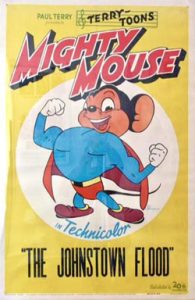 As clever as this origin story is, Terry’s storymen had trouble sticking to it. In 1943, the cartoon Pandora’s Box revealed that this super mouse became super by swallowing vitamins A through Z.
As clever as this origin story is, Terry’s storymen had trouble sticking to it. In 1943, the cartoon Pandora’s Box revealed that this super mouse became super by swallowing vitamins A through Z.
In 1946, the cartoon The Johnstown Flood suggested that a little mouse ranger had to drink from a jug labeled “Atomic Energy” to be transformed into the amazing mouse.
Still later in 1951, the story was again revised in The Cat’s Tale so that a mouse couple raises an orphan baby mouse left on their doorstep. Soon, they discover that he has powers and ability far beyond mortal mice. (This version more closely mimicked not only Superman’s origin but was similar to the version of Mighty Mouse’s origin officially given in his comic book adventures.)
The concept of Super Mouse was instantly popular and another half dozen cartoons were made. Terrytoons staffer, Bill Weiss has claimed that the name of the character had to be changed not because of any complaint from the copyright holders of Superman but because of the existence of another Super Mouse.
While the first animated cartoon was in preparation, a Terrytoons employee left the studio and sold the idea to a comic book publisher. Nedor Publications released COO COO COMICS #1 the very same month that The Mouse of Tomorrow appeared. In that first issue was the adventures of Supermouse (one word) who gained his powers by eating supercheese.
The comic book company had been able to copyright the name before Terry could and Terry was placed in the difficult position of producing cartoons that gave free publicity to the comic book character. In addition, there was the possibility of copyright infringement. Super Mouse was officially changed in 1944 with the release of The Wreck of the Hesperus on February 11th to Mighty Mouse and now Terry could copyright the character and name.
When the earlier Super Mouse cartoons were released to TV, they were re-dubbed and re-titled to eliminate references to the original name even though he retained the same red and blue outfit. The new Mighty Mouse was now costumed in his familiar red and gold outfit and had started to gain some weight and muscle.
Unlike most superheroes, he didn’t have an insignia or logo on his chest or cape. He was a mouse of few words. Generally, his powers seemed limited to flying, super strength and speed with just a degree of invulnerability. (On at least one occasion he also exhibited mystical powers that allowed him to somehow “mentally” command water.)
While Mighty Mouse may be best remembered for his countless battles against mice-hungry felines, he also battled a large assortment of other recurring bullies including a nameless wolf and the melodramatic villain Oil Can Harry.
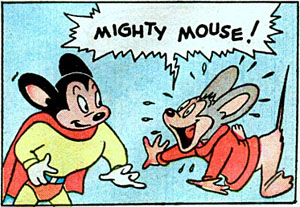 Many of the early Mighty Mouse cartoons followed a format where the champion of justice appeared only within the final moments to save the day. Terry explained that it was a “pattern-made thing” based on the assumption that throughout history people without hope yearn for a magical solution to an insurmountable problem.
Many of the early Mighty Mouse cartoons followed a format where the champion of justice appeared only within the final moments to save the day. Terry explained that it was a “pattern-made thing” based on the assumption that throughout history people without hope yearn for a magical solution to an insurmountable problem.
The Terrytoons’ storymen expanded the stories into little mini-operettas. Later they changed again. Mighty Mouse director Connie Rasinski had directed one of the eight cartoon series produced by Terry in the mid-Thirties. The series had a black mustached fiend known as Oil Can Harry who chased a helpless heroine named Fannie Zilch. Fannie was rescued in true melodrama fashion by a clean cut hero named Strongheart.
The series, a parody of turn-of-the-century melodramas and silent movie serials, had been fairly popular. The Terry staff re-adapted the concept substituting Mighty Mouse for Strongheart and having the mouse appear in all seven minutes not just briefly at the end to save the day. Oil Can Harry was transformed into a cat and the object of his misguided affection became the bland, blonde mouse called Pearl Pureheart.
The first in this series was directed by Rasinski in 1947 and was entitled A Fight to the Finish. For many cartoon fans, the last official Mighty Mouse cartoon was The Reformed Wolf (1954) since it was the last one made before Terry sold his studio.
In 1959-61, Mighty Mouse appeared in three new cartoons: Outer Space Visitor, The Mysterious Package and Cat Alarm. These films were done in a simpler animation style and were generally uninspired adventures with some science fiction elements.
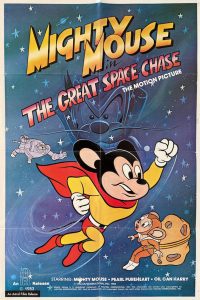 Beginning September 8, 1979, CBS revived the character of Mighty Mouse in a new series of Saturday morning cartoons produced by Filmation. The hour long show was entitled THE NEW ADVENTURES OF MIGHTY MOUSE AND HECKLE AND JECKLE. The settings for the Mighty Mouse stories spanned time and space. Primarily, the basic storylines still concerned Mighty Mouse saving Pearl Pureheart from Oil Can Harry who was now assisted by a bumbling helper, Swifty the cat.
Beginning September 8, 1979, CBS revived the character of Mighty Mouse in a new series of Saturday morning cartoons produced by Filmation. The hour long show was entitled THE NEW ADVENTURES OF MIGHTY MOUSE AND HECKLE AND JECKLE. The settings for the Mighty Mouse stories spanned time and space. Primarily, the basic storylines still concerned Mighty Mouse saving Pearl Pureheart from Oil Can Harry who was now assisted by a bumbling helper, Swifty the cat.
During the hour, Mighty Mouse appeared in two separate adventures and an episode of a sixteen chapter serial, “The Great Space Chase.” (The serial was later edited into a feature and released on home video.) Like most of the Saturday morning cartoons of this period, Mighty Mouse was called upon to educate his viewers with his “Mighty Mouse Environmental Bulletins” concerning things like littering.
The series disappeared after only sixteen installments.
On September 19, 1987, almost a decade after Filmation’s attempt, Mighty Mouse once again returned to CBS’s Saturday morning schedule in a new series. The official title was MIGHTY MOUSE: THE NEW ADVENTURES and it was produced by Ralph Bakshi.
Bakshi had received screen credit for animating one of the last Mighty Mouse cartoons, The Mysterious Package (1961). Bakshi took a highly irreverent approach to the series and tried to re-create the wild spirit of the Warner Brothers cartoons rather than the classic Terrytoons.
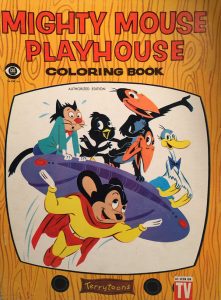 While Mighty Mouse still remained the clean cut hero who protected Mouseville, there were some significant changes. Mighty Mouse was given a secret identity as Mike Mouse, assembly line worker for Pearl Pureheart’s factory. He was also given a mouse kid side-kick named Scrappy, who was constantly getting into trouble.
While Mighty Mouse still remained the clean cut hero who protected Mouseville, there were some significant changes. Mighty Mouse was given a secret identity as Mike Mouse, assembly line worker for Pearl Pureheart’s factory. He was also given a mouse kid side-kick named Scrappy, who was constantly getting into trouble.
Mighty Mouse first appeared in comic books in 1945 in TERRYTOONS published by Timely (now known as Marvel comics). After four issues, the character shifted to a variety of different publishers including St. John and Pines, both of which published not only a MIGHTY MOUSE comic book but an ADVENTURES OF MIGHTY MOUSE comic book as well.
Later, Dell/Gold Key continued both of those titles with each book coincidentally ending with issue #172. Still later, Spotlight and Marvel did short-lived comic book series of the character.
Mighty Mouse was such a strong character that he survived weak stories and poor animation to capture the hearts of decades of fans. He was a mouse whose actions spoke louder than the few words he was given in his many cartoon appearances. He outlasted every other animal superhero parody, proving that he was the mightiest mouse of all.


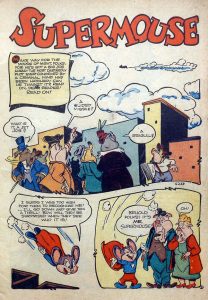
 Jim Korkis is an internationally respected animation historian who in recent years has devoted his attention to the many worlds of Disney. He was a columnist for a variety of animation magazines. With his former writing partner, John Cawley, he authored several animation related books including The Encyclopedia of Cartoon Superstars, How to Create Animation, Cartoon Confidential and Get Animated’s Animation Art Buyer’s Guide. He taught animation classes at the Disney Institute in Florida as well as instructing classes on acting and animation history for Disney Feature Animation: Florida.
Jim Korkis is an internationally respected animation historian who in recent years has devoted his attention to the many worlds of Disney. He was a columnist for a variety of animation magazines. With his former writing partner, John Cawley, he authored several animation related books including The Encyclopedia of Cartoon Superstars, How to Create Animation, Cartoon Confidential and Get Animated’s Animation Art Buyer’s Guide. He taught animation classes at the Disney Institute in Florida as well as instructing classes on acting and animation history for Disney Feature Animation: Florida.




















































Having devoted considerable time to studying the Terrytoons corpus in recent years, I’ve had the great pleasure of reacquainting myself with the classic adventures of Mighty Mouse. No other cartoon series of the ’40s had the same winning combination of action, suspense, comedy, and sex appeal.
Ironically, Mighty Mouse owed his character’s success to the fact that he wasn’t a clearly defined character, but a deus ex machina (I should say, “mus ex machina”) who flew in to save the day in the last two minutes. The nature and scope of his heroics were determined by the setup that preceded them; thus the format allowed him to serve the same purpose in an infinitely wide variety of stories, a paragon of consistent righteousness in a chaotic world. By contrast, the later cartoons with Pearl and Oil Can Harry were constrained by the conventions of the melodramas they parodied. They made the most of their diverse settings, but the plots were pretty much the same.
There are so many outstanding cartoons in this series: the horror spoofs “Frankenstein’s Cat”, “Jekyll and Hyde Cat”, and “Svengali’s Cat”; the operettas “Mighty Mouse and the Pirates”, “Gypsy Life”, and “The Crackpot King”; the maritime adventures “The Wreck of the Hesperus” and “Swiss Cheese Family Robinson”; Bill Tytla’s “The Sultan’s Birthday”; and of course, “Krakatoa”, arguably the Terry studio’s magnum opus. In general I prefer the Mighty Mouse cartoons of the early and mid-’40s over the later ones. There was a noticeable decline in the quality of the Terry product after the 1947-48 strike (meaning no disrespect to the great Jim Tyer).
I would be remiss if I didn’t mention the lively musical scores of Philip Scheib, which always suited the action of the cartoons perfectly. Even though I think he went overboard with all the saxophone scales, there’s no question that the boys in his orchestra had some serious chops. There are many brilliant touches in these scores: for example, in “Mighty Mouse and the Wolf”, a scene of sheep in a meadow is accompanied by a jazzed-up version of the aria “He Shall Feed His Flock Like a Shepherd” from Handel’s Messiah. That’s a clever music joke even Stalling wouldn’t have though of.
I love your Disney-related articles, but it’s a real treat for me that you’ve turned your attention to the Terry studio and its greatest and most enduring hero. What a post! And what a mouse! What — a — mouse!
This post was a GREAT one. Thank you, much!!!
That tinny little a cappella intro theme to MMPlayhouse might be the result of Terry’s infamous stingy budget, but it’s the one that stuck with me forever. Just weird enough to be memorable.
The fully-realized fanfare that materialized later was also good, but only when “sung” by Andy Kaufman.
Will the Mighty Mouse toons ever see the light of day?
As I’ve noted before, it struck me early on how Terrytoon’s villain cats often regarded mice as entrees, but sometimes as objects of lust (especially in the Pearl Pureheart and Oil Can Harry entries). If they ever took both attitudes in the same cartoon, I must have blocked it out of memory.
I’m growing pessimistic about ever seeing a legit Terrytoons DVD set.
The late, great Andy Kaufman did the definitive performance of the Mighty Mouse song.
Speaking of that, I was recently made aware that Jimi Hendrix also made reference to the song at the beginning of “Astro Man” from his album “Cry Of Love”.
SORRY THIS SO OFF TOPIC.BUT I REALLY ENJOY YOUR ARTICLES.HAVE YOU EVER WRITTEN ANYTHING A BOUT A SMALL CARTOON SERIES CALLED SIMON IN THE LAND OF CHALK DRAWINGS?I VAUGELY REMEBER LIKING IT IN MY CHILDHOOD.BUT WOULD LOVE TO KNOW MORE ABOUT HOW IT CAME ABOUT.
Your caps lock seems to be stuck.
Hi David, You didn’t mention which country you saw “Simon” in. It was originally a British TV series, based on a series of children’s books. When the cartoons aired in the USA on the Captain Kangaroo show, new narration was recorded by host Bob Keeshan. Later, a second series for Canadian TV was narrated by Ernie Coombs, star of the long-running CBC kids’ show “Mr. Dressup”. That was the version that aired in Australia (where, ironically, Captain Kangaroo has never been shown). If you’re interested in details of its conception and production, try the BFI, or see if there are any fan sites devoted to it; but remember, it all depends on which version of the show you mean.
HEY,THANKS FOR THE INFO ON SIMON.I DID SEE IT ON CAPT.KANGAROO.[YEP IM GETTING OLD]SORRY ABOUT THE ALL CAPS.BUT ITS GETTING HARDER TO SEE WHAT I TYPE THESE DAYS.THANK YOU AGAIN.
As I recall, the only time in a Terrytoon cartoon (that is, not a made-for-TV cartoon) where Mighty Mouse actually says, “Here I come to save the day!” is his “cameo” appearance in the Gandy Goose and Sourpuss cartoon “Comic Book Land.”
He sings the line in “Crying Wolf” (1947).
As well as “A Cold Romance” (1949).
And also “The Witch’s Cat” (1948).
Plus “Perils of Pearl Pureheart” (1949).
And he sings “Here I AM to save the day!” in “Sunny Italy” (1951).
I used to drive past New England Playworld all the time, with its huge Mighty Mouse sign out front. Inside, they sold Terrytoons merch featuring MM, Heckle & Jeckle, Deputy Dawg and other stars. There were even live shows with costumed versions of some characters. I still have (preserved in picture frames) nice posters of Little Roquefort, Deputy Dawg and Possible Possum.
TV budget animation not withstanding, I liked Cat Alarm. I had also heard that in the early forties Disney wanted to discontinue Mickey Mouse but when Mighty Mouse started to gain momentum Disney kept Mickey going so as not to be overtaken by a low budget expy.